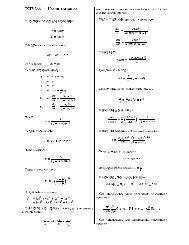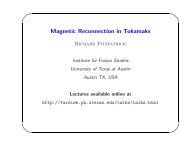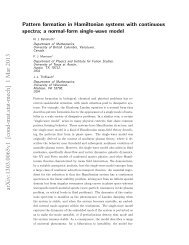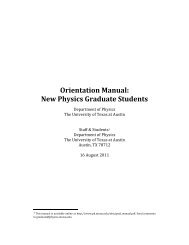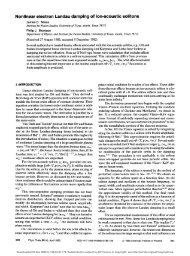Magnetic Fields and Magnetic Diagnostics for Tokamak Plasmas
Magnetic Fields and Magnetic Diagnostics for Tokamak Plasmas
Magnetic Fields and Magnetic Diagnostics for Tokamak Plasmas
You also want an ePaper? Increase the reach of your titles
YUMPU automatically turns print PDFs into web optimized ePapers that Google loves.
<strong>Magnetic</strong> fields <strong>and</strong> tokamak plasmas<br />
Alan Wootton<br />
Energy associated with toroidal fields W 1<br />
B<br />
The energy associated with poloidal currents is written as<br />
W B 1<br />
= L I 2<br />
1 1<br />
2 + L I 2<br />
1e 1e<br />
2<br />
+ M 1<br />
I 1<br />
I 1e<br />
6.0.5<br />
Here I 1 is the poloidal current in the plasma, <strong>and</strong> I 1e is the poloidal current in the toroidal field<br />
coil (subscript e <strong>for</strong> external). I 1 is that poloidal current flowing in the plasma edge which<br />
produces a toroidal field equal to the difference between the internal toroidal field B φi <strong>and</strong> the<br />
external toroidal field B φe . By definition we have<br />
L 1<br />
I 1<br />
2<br />
( ) 2 V<br />
B<br />
2 = φi<br />
− B φe<br />
6.0.6<br />
2µ 0<br />
( B φi<br />
− B φe )B φe<br />
V<br />
M 1<br />
I 1<br />
I 1e<br />
=<br />
6.0.7<br />
µ 0<br />
Now the circuits I 1 <strong>and</strong> I 1e are perfectly coupled, so that L 1 = M 1. The field B 1 = µ 0 I 1 /(2πR), <strong>and</strong><br />
so<br />
B 1<br />
2<br />
M 1<br />
= L 1<br />
= 1 ⎛<br />
2<br />
I 1<br />
∫ dV = µ 0<br />
R − R 2 − a 2<br />
µ ⎝<br />
0<br />
V<br />
( ) 1 2<br />
⎞<br />
⎠ ≈ µ a 2<br />
0<br />
2R<br />
6.0.8<br />
<strong>for</strong> skin currents. To get the <strong>for</strong>ces we will need only the functional dependencies, namely<br />
∂L 1<br />
∂a = 2 L 1<br />
a<br />
∂M 1<br />
∂a = 2M 1<br />
a<br />
∂L 1<br />
∂R = − L 1<br />
R<br />
∂M 1<br />
∂R = − M 1<br />
R<br />
6.0.9<br />
6.0.10<br />
The <strong>for</strong>ces will be computed at constant current. For example, the part of the <strong>for</strong>ce due to<br />
∂/∂R(L 1 I 1 2 /2) is then written as (I 1 2 /2)∂/∂R(L 1 ) = -(I 1 2 /2)L/R = -(L 1 I 1 2 /2)(1/R). Using Equation<br />
6.0.6 this becomes (I 1 2 /2)∂/∂R(L 1 ) = V/(2Rµ 0 ). Doing this <strong>for</strong> each component in<br />
Equation 6.0.5 gives<br />
47










